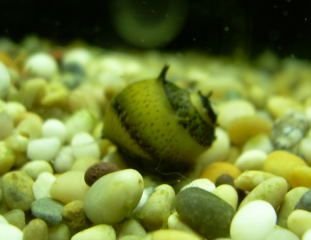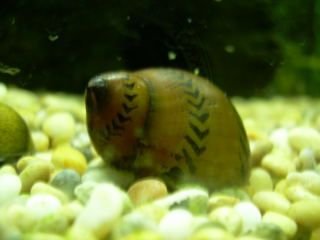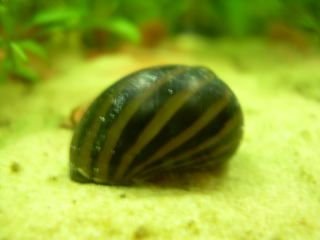Tommo
Fish Fanatic
Common Name(s): Nerite snails: ruby, zebra, bumblebee, racing stripe, hairy and horseshoe to name just a few
Scientific Name: Neritina natalensis, N. funiculata etc
Family: Neritidae
Origin: Tropical waters around the world
Maximum Size: Growth rates very slow but can reach 1 ½ inches
Minimum Tank Size: 3 UK gallon
Life Span: Typically 2-3 years but can be much more
Care: They can adapt to a wide variety of water conditions and those sold in shops should be true freshwater Nerites, yet brackish and saltwater species are also available.
Preferred temperature: 24 – 26
Preferred pH: 7-9 (less than 7 is damaging to the shells)
Feeding: They are excellent algae eaters, especially of diatom algae. They can be offered any algae based food, such as spirulina or plecostamus wafers but this is often not required as in established tanks their should be plenty of algae for them to graze upon.
Breeding: Nerites will not breed in the aquarium as they have a very complex breeding cycle, the eggs requiring brackish water to hatch.
Notes: Very efficient algae eaters.A colourful choice for the aquarium.
Do not keep with loaches or large puffers, as they will be eaten.
Can remain motionless for days
Cannot get back up if they fall on their backs, so a helping hand is needed
Sometimes nerites lay eggs in the aquarium which wont hatch, but are incredibly difficult to remove.
My Nerites:

Bumblebee nerites

Racing stripe nerite

Zebra nerite
Scientific Name: Neritina natalensis, N. funiculata etc
Family: Neritidae
Origin: Tropical waters around the world
Maximum Size: Growth rates very slow but can reach 1 ½ inches
Minimum Tank Size: 3 UK gallon
Life Span: Typically 2-3 years but can be much more
Care: They can adapt to a wide variety of water conditions and those sold in shops should be true freshwater Nerites, yet brackish and saltwater species are also available.
Preferred temperature: 24 – 26
Preferred pH: 7-9 (less than 7 is damaging to the shells)
Feeding: They are excellent algae eaters, especially of diatom algae. They can be offered any algae based food, such as spirulina or plecostamus wafers but this is often not required as in established tanks their should be plenty of algae for them to graze upon.
Breeding: Nerites will not breed in the aquarium as they have a very complex breeding cycle, the eggs requiring brackish water to hatch.
Notes: Very efficient algae eaters.A colourful choice for the aquarium.
Do not keep with loaches or large puffers, as they will be eaten.
Can remain motionless for days
Cannot get back up if they fall on their backs, so a helping hand is needed
Sometimes nerites lay eggs in the aquarium which wont hatch, but are incredibly difficult to remove.
My Nerites:

Bumblebee nerites

Racing stripe nerite

Zebra nerite
